搜尋結果
2015 Ogasawara earthquake. Coordinates: 27.839°N 140.493°E. The 2015 Ogasawara earthquake was a 7.8 magnitude earthquake which struck offshore Japan 189 km (117 mi) west northwest of Chichi-jima in the Ogasawara Islands on May 30 at a depth of 664.0 km (412.6 mi). [1] .
- May 30, 2015
- 2015-05-30 11:23
The 1896 Rikuu earthquake ( Japanese: 陸羽地震) is an inland earthquake that occurred on August 31, 1896, near the border between Akita and Iwate prefectures, Japan. [5] [6] Magnitude was 7.2. [7] . The earthquake left 209 people dead (205 people dead in Akita Prefecture) and 779 people injured. [8] .
- 209 dead, 779 injured
- M7.2
- August 31, 1896
- Senya Fault
- Earthquake Names in Japanese Media
- City Introduction
- Description
- Historical Earthquakes and Geology in The Surrounding Area
- Aftershocks
- Effects
- See Also
- External Links
The Japan Meteorological Agency referred to the earthquake as the "Earthquake off the western coast of Fukuoka Prefecture" in their press release. While Fukuoka Prefecture and Fukuoka City, as well as major media outlets such as the Asahi Shimbun and NHK, used "Fukuoka Prefecture Western Offshore Earthquake." The Nishinippon Shimbun and Yomiuri Shi...
Fukuoka is located in the northern Kyushu, Japan, and it is in the center of the Fukuoka plain. Fukuoka is the most populous and developed prefecture in Kyushu. Geographically, Fukuoka is close to mainland East Asia, and the nearest megacity to Fukuoka is Seoul, South Korea, rather than a domestic Japanese city. Fukuoka is about as far from Shangha...
The strong earthquake occurred at 10:53 am in the Kyushu region, about 70 km west of Shimonoseki city in Yamaguchi prefecture. The earthquake occurred on Sunday, March 20, 2005, which was also a public holiday known as Vernal Equinox Day, falling in the middle of a three-day weekend. The depth of the earthquake was extremely shallow, with a presume...
The seismic activity in the offshore area northwest of Fukuoka Prefecture has historically been low, with few records of significant earthquake activity. Geological literature published before the earthquake often described northern Kyushu, north of the Beppu-Shimabara Trench, as relatively geologically stable, occasionally experiencing only small ...
Between the occurrence of the main earthquake and the end of June 2005, there were 375 aftershocks with a seismic intensity of 1 or higher recorded over a period of just over three months. By 9 p.m. Tuesday, 85 aftershocks had been recorded. Within a month of the quake, there were four aftershocks with a magnitude of more than 5, including the larg...
Architecture
During this earthquake, more than half of the 225 residential buildings on the Genkai Island in the western part of Fukuoka city, near the epicenter, suffered serious damage. The island was particularly hard hit because it near to the quake and traditional Japanese homes are less vulnerable to earthquakes than "mansions" that are built by engineers. In Kaido, about 120 homes were destroyed and another 55 damaged partially. Traditional Japanese houses, particularly in the areas of Daimyō and I...
Transportation
According to public broadcaster NHK, local rail services were suspended after the tremors triggered an automatic safety mechanism. The operation of the San'yō Shinkansen between Shin-Yamaguchi and Hakatawas temporarily suspended. The cracks appeared on sidewalks in residential areas.
Other Effects
Officials reported water and gas breaks and power outages. Telephone service in the southern prefecture was jammed after an automatic safety mechanism was triggered by the tremors. The quake also caused 103 gas leaks. The meteorological agency issued a tsunami warning after the strong earthquake, but lifted it at noon. Landslides occurred around Fukuoka, Saga and Nagasaki prefectures.
33°44′18″N 130°10′30″E / 33.738333°N 130.175°E / 33.738333; 130.175The International Seismological Centre has a bibliography and/or authoritative datafor this event.其他人也問了
Is Japan heading into freefall after earthquake & tsunami?
Will earthquake rebuilding outweigh Japan slump?
What happened after quake & tsunami?
At 9:41:58 a.m. on March 25, 2007, a magnitude 6.9 earthquake struck the Hokuriku region of Japan, near the Noto Peninsula. The earthquake shook the city of Wajima, the city of Nanao, and the town of Anamizu with a seismic intensity of 6+ on Japan's shindo scale. [6] One death, in the city of Wajima, and at least 356 injuries have been reported ...
A convoy of fire engines in the tsunami zone. The aftermath of the 2011 Tōhoku earthquake and tsunami included both a humanitarian crisis and massive economic impacts. The tsunami created over 300,000 refugees in the Tōhoku region of Japan, and resulted in shortages of food, water, shelter, medicine and fuel for survivors. 15,900 deaths have ...
The 1983 Sea of Japan earthquake ( Japanese: 日本海中部地震) occurred on May 26, 1983 at 11:59:57 local time (02:59:57 UTC ). It had a magnitude of 7.8 on the moment magnitude scale. It occurred in the Sea of Japan, about 100 km west of the coast of Noshiro in Akita Prefecture, Japan.
South Kantō earthquakes ( Japanese: 南関東直下地震) or Greater Tokyo Area earthquakes ( Japanese: 首都直下地震) are general terms for major earthquakes that occurs repeatedly historically in the southern part of Kanto region ( Tokyo, Kanagawa, Chiba, Saitama, etc, Greater Tokyo Area) in Japan.





